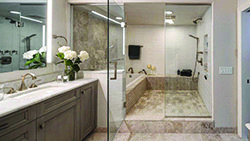We live in a lovely spot—as the French would say, endroit—but the truth is, many of our Westchester homes are old-ish, built in the post WW II boom or prior to. Kitchens are isolated and oft decrepit. Living rooms are not for the living. Need I say more?
My customers are realizing that the costs of moving—the real, obvious costs (movers, packing, painting, floor refinishing) and the hidden costs (towel bars, paper towel holders, closet hooks, not to mention finding a new dry cleaner or pediatrician)—are daunting. And we’re all increasingly aware that real estate is not the golden goose of yore; no longer can we count on creating wealth by owning, selling at a usurious profit, and moving on. Rather people are committing to their communities, their homes, their lifestyles. Content with who they are and how they live. Or, more specifically, content with an agenda that involves renovating or refurbishing.
The DeLisios, who live in an updated Tudor in Poet’s Corner, have signed on for serial renovations. Currently they’re in the thick of it—combining the kitchen and dining room to create an open plan kitchen/family room and turning a small study at the end of the kitchen-adjacent living room into an intimate and proper dining room. And this after they just finished colonizing the third floor, adding a bath, a hang-out space for their tween twins, and a home office for architectural designer Lynn. Are they gluttons for punishment? Not at all. They’ve taken stock of where they are and decided they love their neighborhood, front terrace, and generous square footage. And the DeLisios are not done yet. Next on the list? The master bath, natch.
The Carmichaels have been in their Colonial home in the Pinebrook area for six years. With three school-age children they’ve been feeling the need to reclaim the living room for both entertaining and, well—plain old living. The family room gets mighty crowded, especially as their youngest is extremely creative; naturally, she likes to create on the family room floor. (Being the baby of the family, she can do whatever she wants—at least that’s the way it worked in my family.) With good natural light, lovely exterior stonework, a pretty yard, and a convenient location, the Carmichaels have also opted to stay put. The challenge—how to make the living room more livable? Here, our first move was to start with an electric fireplace to give the room a focal point and help define the furniture layout. If you’re feeling similarly inclined, check out SanMarcos off Palmer Avenue, which has recently added a wonderful gas and electric fireplace 1,000 square foot showroom.
For new customers who are making the suburban pilgrimage from Bed-Stuy and environs, I find certain trends are more likely to inspire a desire to put down roots. Or not. One-and-all are acknowledging the waning of grey, for example, as gray rooms have a distinct habit of looking the same. One customer complained that every house being flipped or built is “super modern”—aka, blandly modern. This young NYC transplant is hankering for something more traditional. But NOT conventional, she cautions.
Whether customers are new to the hunt or long-time owners looking to up their design
game, I often recommend investing in the hardscape of floors and walls (and of course furniture and fabrics—I am a designer, after all). When it comes to wood flooring, I’m a big fan of quarter-sawn and riffed three inch white oak. It sets the house apart and sets the stage for your interiors. As for stain color, I’m still drawn to the warmth of the mid-toned woods. (Sidebar: How can Dark Walnut be lighter than Special Walnut on my favorite Minwax chart? Proof that you can’t count on names alone.) And while I’ve always appreciated the insta-architecture power of moldings—which can add presence to even the most generic spaces—I’ve become a convert to applied molding. Applied is a polite way to say the molding is just adhered to your walls with glue or small nails, no major construction required. Often this easy upgrade can elevate a room as effectively as raised paneling, which costs the earth and the moon and takes forever. I have recently floor-to-ceiling paneled a double height front entry. And in a girl’s bedroom added 48”-high V-groove with a small cap, which created both architecture and a display ledge. Collectibles ran around the entire perimeter and the then-teen owner changed the tableau as often as her beaus.
So perhaps the mantra is simply: Don’t go— please stay. (Or, as Jackson Browne once crooned: “Oh, won’t you stay…just a little bit longer…”) There are lots of ways to make a house work for you and yours.



